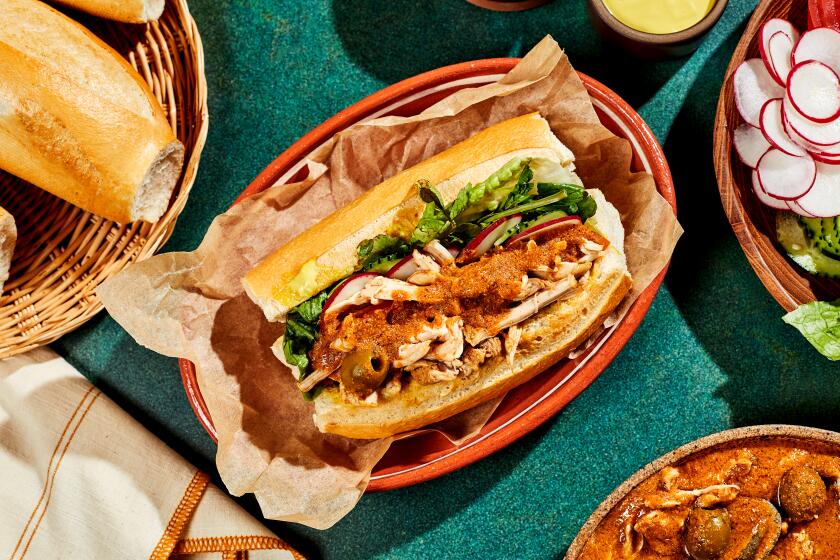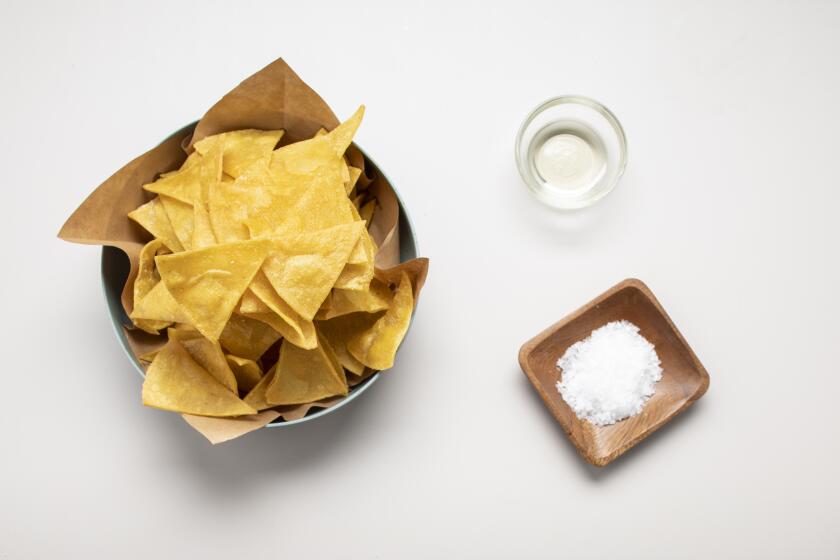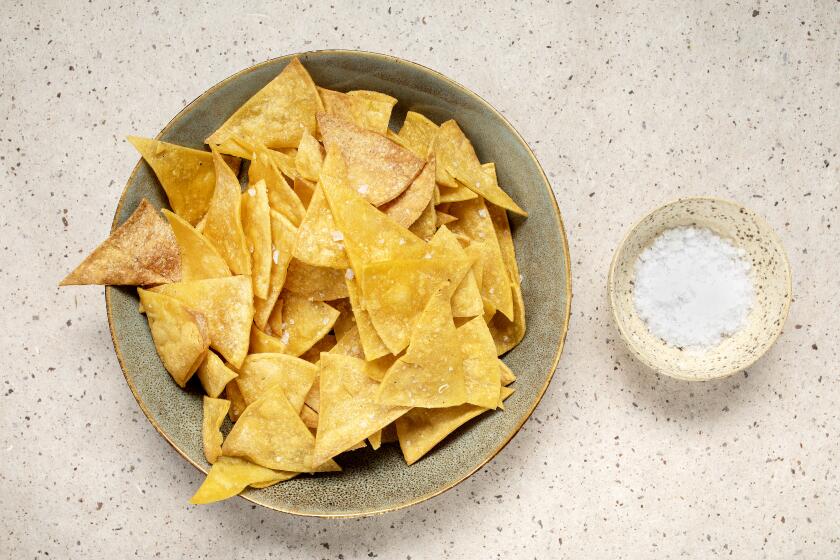Butter monkey bread
- Share via
Of all the heirloom family recipes tucked away in my converted shoe box (iPhone apps have nothing on 3-by-5 cards), one for monkey bread ranks second only to my great-grandmother’s biscuits as the most tattered.
It’s not because the Eisenhower-era pull-apart bread glistening with butter is a weeknight staple at my house. In fact, until recently the card probably hadn’t ever left the box. The card’s wear and tear came from all the previous generations tweaking the bread with a little more butter this time, baking it in a loaf pan the next, or adding more yeast.
If only recipes with PBS-worthy histories always worked better after all that passing down and messing around. It still took a couple of nights of persistent tweakings and several trips to my cookbook library and even more to the oven to get a monkey bread recipe that worked as well as I wanted.
In the end, I had to pass on my grandmother’s recipe; it turns out that too much butter causes a saggy middle (go figure) and if you pile up the dough in a loaf pan the way she suggests, the bread tends to collapse after baking. But the good news is that once I had the basic monkey bread recipe down, I found it could stand up to all sorts of variations -- and was easy enough to make that I could work it into last-minute weekday dinners.
It turns out the trick with this buttery yeast bread is to pay close attention to the technique. How long you knead the dough, what size to cut the pieces prior to baking, the type of pan you use -- they are all important.
Once you get those basics down, monkey bread is relatively easy to morph into special-occasion-worthy variations. How about a caramelized brown sugar-walnut version for a lazy autumn brunch? Or an olive oil-thyme version to go with whatever is on the grill?
--
Where it began
Some culinary historians speculate that monkey bread evolved from Parker House rolls, the late 19th century crescent-style rolls nestled side by side in a sheet pan (when baked in a ring mold or Bundt pan, the bread was said to resemble the prickly Chilean monkey puzzle tree).
Others maintain it was the creation of silent film actress ZaSu Pitts and her neighbor, Ann King, a Texas housewife who moved to Burbank during the 1940s after her husband landed a job at Lockheed Martin. The women reportedly named the bread after the neighborhood children, little meddling “monkeys” who couldn’t keep their fingers out of the steaming fresh-from-the-oven bread. (King opened a bakery specializing in monkey bread shortly after she returned to Texas.)
Whether the bread evolved from multiple influences or was truly “invented,” variations began appearing in the Los Angeles Times as early as 1946. Today, there are so many versions I found it difficult to settle on one basic recipe.
I figured that matrons of 1960s home cooking would be a good place to start, and it turned out the best version I found was by Helen Corbitt, the Julia Child-esque cooking celebrity with a Texas twang and a penchant for Neiman Marcus (she was the department store’s restaurant chef).
With a few tweaks, including cutting down on the yeast (older recipes often call for excessive quantities by today’s standards), Corbitt’s version was a keeper.
One thing to keep in mind when making very moist, butter-rich doughs is they will be sticky. And that’s a good thing. With all that moisture from the butter, the bread still manages to taste light.
Be mindful not to over-knead the dough (it’s never going to look completely smooth the way your typical bread dough would). It’s ready to rise when the dough is slightly sticky but feels soft when you roll a small piece into a ball.
Despite this stickiness, monkey bread dough is surprisingly easy to roll out. A light dusting of flour and a few strokes with a rolling pin are all it takes to get it the requisite one-quarter-inch thick.
You can cut the dough into the classic monkey bread shape, triangles. But rectangles are easier to cut and don’t need to be as precise. Run a pizza cutter across the dough until you have pieces that are about 2-by-1 inches. Any misshapen end pieces will blend together as they bake.
Let the dough rise until doubled, about an hour, and it will be ready to transform into your favorite variation.
The most time-consuming job is dipping each rectangle in melted butter. Tiny kitchen helpers’ hands come in handy, but even without the kids it takes only a few minutes.
Next, pile the butter-dipped pieces into a Bundt pan. The hole in the middle of the pan helps distribute the dough’s weight. A pan with a large surface area, such as a 10-inch cake pan, works well too.
This is one of those breads that won’t look perfectly golden all over when it’s ready to pull from the oven. And that’s fine. After it cools a few minutes you’re going to flip it upside down so the bottom is now the gorgeous golden top. For the most oohs and aahs, bring the whole thing to the table while it is still steaming.
--
‘Bubble bread’
It’s easy to transform the basic monkey bread dough into fantastically gooey brown sugar-cinnamon breakfast bread. Instead of cutting the dough into rectangles, pinch off small pieces and roll them in cinnamon-laced sugar (if you want to get technical, it’s now called “bubble bread,” a variation using balls of dough).
Place the dough rounds side-by-side, not too tightly, in a large cake pan with a little brown-sugar-laced melted butter on the bottom. You’re going to add more butter later, so no need to dip the pieces. A sprinkle of toasted walnuts on top adds a nice crunch. Once the dough has risen, pour the remaining brown sugar-butter mixture over the whole thing. As the bread bakes, the butter will work its way down to the bottom of the pan.
So when you flip the bread out of the pan, what is now the top is all buttery-crunchy with the caramelized brown sugar. It’s way better than refrigerated cinnamon rolls that come in a can.
Or take it in a more contemporary direction (Mediterranean monkey bread?). Instead of dipping the dough rectangles into butter (or pouring butter over the top), swirl each piece in olive oil flecked with minced garlic and your favorite herbs. Thyme and parsley are always a great combination, or try a little rosemary and oregano, whatever you’ve got on hand.
Bake until golden brown and pull the bread apart at the table, piece by herb-scented piece. Think of it as Grandmom’s version, only without the saggy middle.
Basic monkey bread dough
In the bowl of a stand mixer or in a large bowl, drizzle the yeast over the warm milk, stirring to combine. Set aside for a few minutes to hydrate the yeast.
Meanwhile, in a separate large bowl, sift together the flour, sugar and salt.
Using the paddle attachment with a stand mixer, or a hand-held mixer, beat the softened butter into the yeast mixture. With the mixer running, add the flour mixture until thoroughly combined, scraping down the sides of the bowl as needed (as the dough thickens you may need to do this by hand). Continue to mix on medium speed until the dough appears sticky but becomes smooth to the touch when you roll a small piece into a ball, about 2 minutes.
Form the dough into a disc and transfer it to a lightly greased bowl. Cover loosely with plastic wrap and set aside to rise in a warm place until doubled in volume, about 1 hour (time will vary depending on the temperature in the room).
Assembly
Punch down the risen dough and turn it out onto a lightly floured work surface. Roll the dough into a rectangle one-fourth-inch thick. Using a pizza cutter or sharp knife, cut the dough into 1-by-2-inch rectangles. (The dough can also be cut into triangles, but rectangles are speedy and easy. It’s also OK if some of the end pieces are imperfect; just intersperse them among the prettier rectangles and the bread will bake up great.)
Dip each dough rectangle into the melted butter and arrange the rectangles in the bottom of a nonstick Bundt pan, crisscrossing and overlapping the pieces. Continue until all of the dough is used.
Cover the Bundt pan loosely with plastic wrap and set aside until dough is risen and comes almost three-fourths up the sides of the pan, about 1 hour. Meanwhile, heat the oven to 350 degrees.
Uncover the pan and bake until the bread is puffed and lightly golden brown on top, about 25 to 30 minutes, rotating the pan halfway through baking for even coloring.
Remove to a rack and cool, still in the pan, for 15 minutes. Gently flip the monkey bread upside down onto a serving plate and serve warm.
Get our Cooking newsletter.
Your roundup of inspiring recipes and kitchen tricks.
You may occasionally receive promotional content from the Los Angeles Times.















